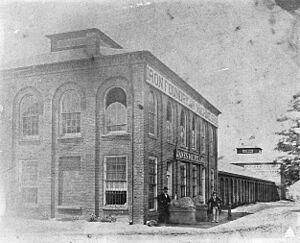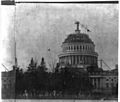Adrian Janes facts for kids
Adrian Janes (born February 4, 1798 – died March 2, 1869) was an important American businessman. He owned a large iron foundry in the Bronx, New York. A foundry is a factory where metal is melted and poured into molds to create different shapes.
His foundry made iron parts for many famous buildings and structures. These include the Capitol Dome of the U.S. Capitol Building in Washington D.C., the Bow Bridge in Central Park, and railings for the Brooklyn Bridge.
Around 1855, Janes' company, Janes, Beebe & Co., published a book showing their beautiful iron designs. Sometimes, people mistakenly call the company James Bebe or James Beebe.
Contents
Adrian Janes' Life Story
Adrian Janes was the son of Mary Warren and Alfred Janes. His father, Alfred, worked in the shoe business and also ran a hotel. He even made mirrors and painted houses. Adrian had an older sister named Eliza. She was the mother of a famous landscape painter, Frederic Edwin Church.
In 1823, Adrian Janes married Adaline Root. They had six children: Julia, Henry, Edward, George, Charles, and Mary. Before starting his foundry, Adrian sold wallpaper and paint brushes in Hartford, Connecticut, from 1821 to 1844. He was also an oil painter, so he probably designed the wallpaper he sold. It's thought that his nephew, Frederic Edwin Church, learned about design and colors from his Uncle Adrian.
Starting the Iron Business
In 1844, Adrian Janes and William Beebe started their iron foundry, Janes, Beebe & Co. It was first located in Manhattan, New York. In 1857, the company moved to Morrisania in the Bronx. The company changed its name in 1859 after William Beebe passed away. It became Janes, Fowler, Kirtland & Co. Adrian Janes, Charles Fowler, and Charles A. Kirtland ran it.
By 1870, the company was called Janes & Kirtland. It was located at 725 6th Avenue.
Adrian Janes' Home
In April 1857, Adrian and Adeline Janes bought land from Gouverneur Morris II. They lived in a large house on this property. Adrian Janes named his property Mary’s Park, after his daughter. Today, this area is known as St. Mary’s Park.
Adrian Janes died in 1869. He is buried in Woodlawn Cemetery in the Bronx. Charles A. Kirtland continued the business until 1880. Then, Adrian Janes' son, Edward E. Janes, took over. Later, Edward's two sons, Henry and Herbert Janes, ran the company. The firm, Janes & Kirtland, stayed in business until the early 1940s.
Wallpaper Business (1821-1844)
From 1821 to 1844, Adrian Janes and Edwin Bolles ran a wallpaper business called Janes & Bolles in Hartford, Connecticut. Their company created the oldest known book of American wallpaper samples that still exists today. This special book is kept at Old Sturbridge Village in Sturbridge, Massachusetts.
Famous Iron Projects (1844-c.1940)
Adrian Janes' foundry made many important iron structures.
The U.S. Capitol Dome
- Janes, Fowler, Kirtland & Co. was in charge of making and putting together the huge cast-iron Dome for the U.S. Capitol Building in Washington, D.C.
- The architect Thomas Ustick Walter designed the dome.
- Work on the dome began in 1858 and continued even during the Civil War.
- In 1863, President Lincoln said that seeing the Capitol being built showed that the United States would continue.
- The dome was finished in 1864. It weighs almost 9 million pounds and cost $1 million to build.
Other Government Buildings
Janes' company also worked on other important government buildings:
- The ceilings of the Senate Chamber and House of Representatives in the U.S. Capitol.
- The Congressional Library in the U.S. Capitol Building (1852).
- Parts of the Patent Office, including a furnace (1851) and a roof (1855).
- The General Post Office.
- The Treasury Building.
- The Court House and Post Office in Portland, Maine (1871).
- Lanterns for the Capitol building (1874).
Brooklyn Bridge
- The company made the cast-iron railings for the famous Brooklyn Bridge.
Bow Bridge
- The Bow Bridge is one of the most well-known and photographed spots in Central Park.
- Built in 1862, this bridge stretches 60 feet across the Central Park Lake. It connects Cherry Hill and the Ramble areas.
- The bridge is named "Bow Bridge" because its curved shape looks like an archer's bow.
- It is the oldest cast-iron bridge in Central Park and the second-oldest cast-iron bridge in the entire United States.
- Calvert Vaux and Jacob Wrey Mould designed it.
Fountains
Janes' foundry also created many beautiful fountains:
- The Forsyth Park Fountain in Savannah, Georgia (1858).
- The Soldiers' Memorial Fountain in Poughkeepsie, New York (1870).
- A fountain in Abbeville, South Carolina.
- The Plaza de Armas Fountain in Cusco, Peru.
- Fountains were also sent to places like Cuba, Haiti, Hawaii (then called the Sandwich Islands), Mexico, South America, and China.
Furniture
- In 1859, the U.S. Congress ordered 48 benches for the House chamber. Constantino Brumidi designed the sides of these benches, and Janes, Beebe & Co. cast them.
- Today, 14 of these original benches (and 2 copies) are in the Capitol Rotunda.
- Janes, Beebe & Co. also made iron benches and chairs in a "Victorian rustic" style. These often looked like they were made from tree branches.
- The Smithsonian Institution, the Metropolitan Museum of Art, the Brooklyn Museum, and Historic New England have examples of this furniture. Benches with the foundry's special mark are very rare.
- By 1927, the company was making kitchen cabinets called the "White House Line."
Sculptures and Other Works
- The foundry made religious statues.
- They created the Pillot dogs sculptures at the Pillot House in Sam Houston Park, Houston, Texas. The original sculptures were made around 1870, and new ones were made in 1989.
- They also worked with cast zinc to make sculptures.
- Household items made by Janes & Kirtland were shown in a 1934 art exhibition called 'Machine Art' at the Museum of Modern Art in New York.
Cooking Ranges and Furnaces
Janes' company also installed furnaces and made cooking ranges:
- Furnaces were installed in famous churches like St. Patrick's Cathedral and Trinity Church in New York City.
- They made a stove for the Vanderbilt Mansion in Hyde Park, New York.
- A cooking range was made for the Edgar Allan Poe Cottage in the Bronx, New York.
- A kitchen stove was made for Hyde Hall in Cooperstown, New York.
St. Mary's Park
- St. Mary's Park in the Bronx is named after Adrian Janes' daughter, Mary.
- There was once a church nearby on Alexander Avenue that was also named after her.
- In the northern part of the park is Janes’ Hill, which is where the Janes family mansion used to stand.
See Also
- Illustrated Catalogue of Ornamental Iron Work
- Photo of Adrian Janes' residence
- Detailed look at the Capitol Dome
- Papers relating to Capitol Dome construction
- Correspondence about Capitol Dome
- Photo of Haitian fountain
- Advertisement for garden ornaments (1860)
- Photo of Capitol Rotunda bench
- Smithsonian Institution: Rustic Pattern Bench
- Metropolitan Museum of Art: Iron Chair
- Brooklyn Museum: Iron Bench
- Historic New England: Iron Bench
- White House Line kitchen cabinet catalog I
- White House Line kitchen cabinet catalog II
- White House Line advertisement
- Advertisement for religious statuary
- Cast-iron veranda
- 'Machine Art' exhibition catalog
- Hyde Hall kitchen stove inventory
- Cooking ranges catalog






















